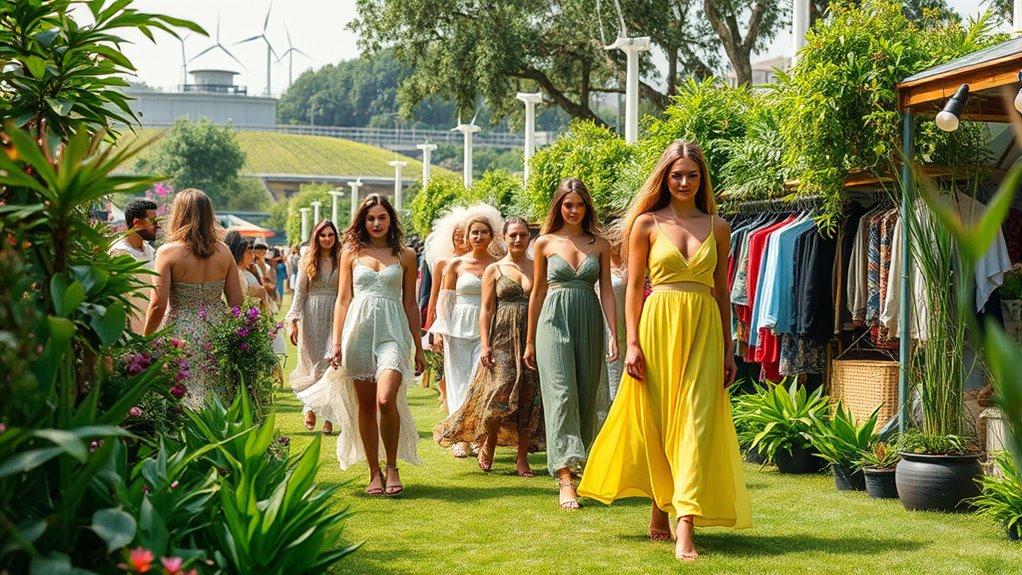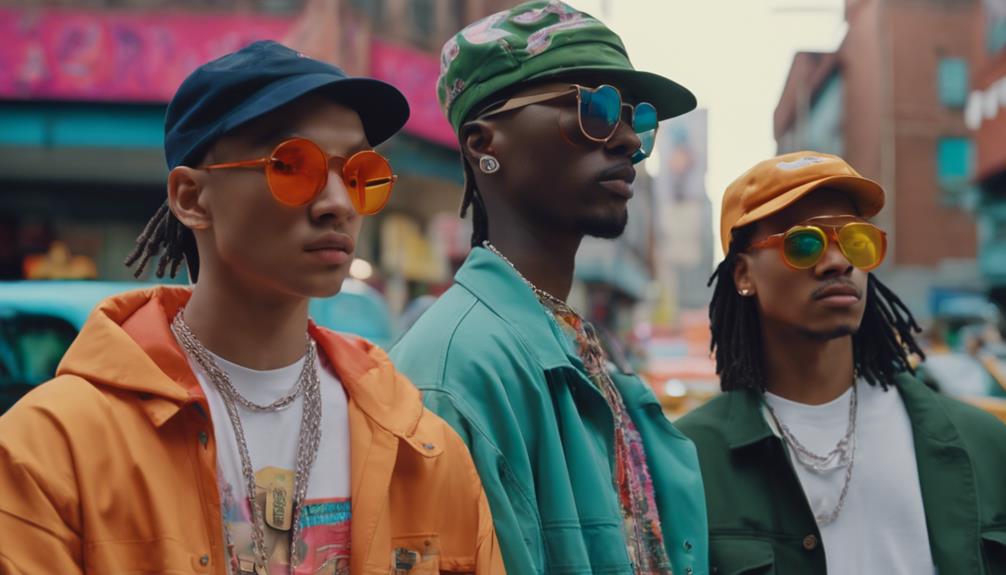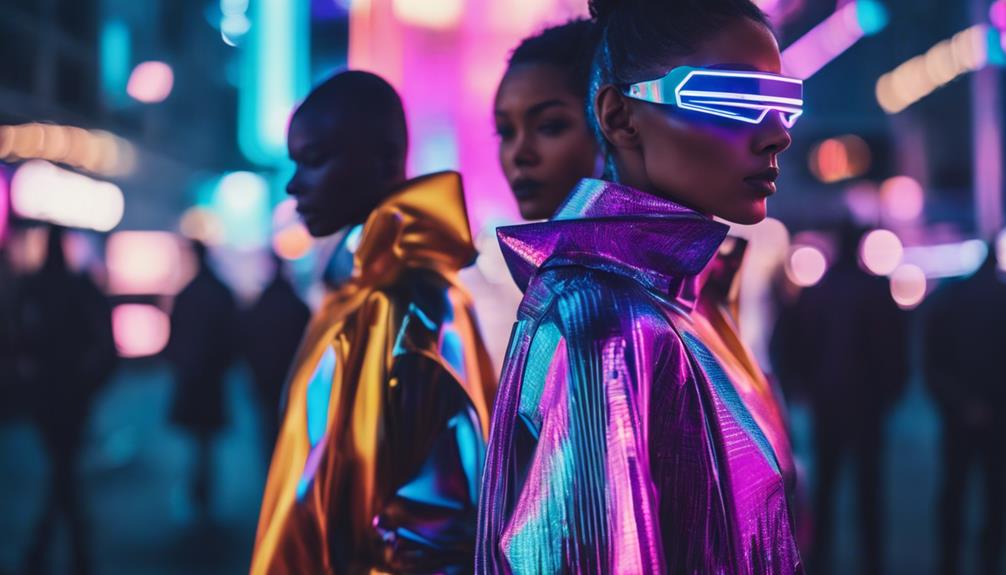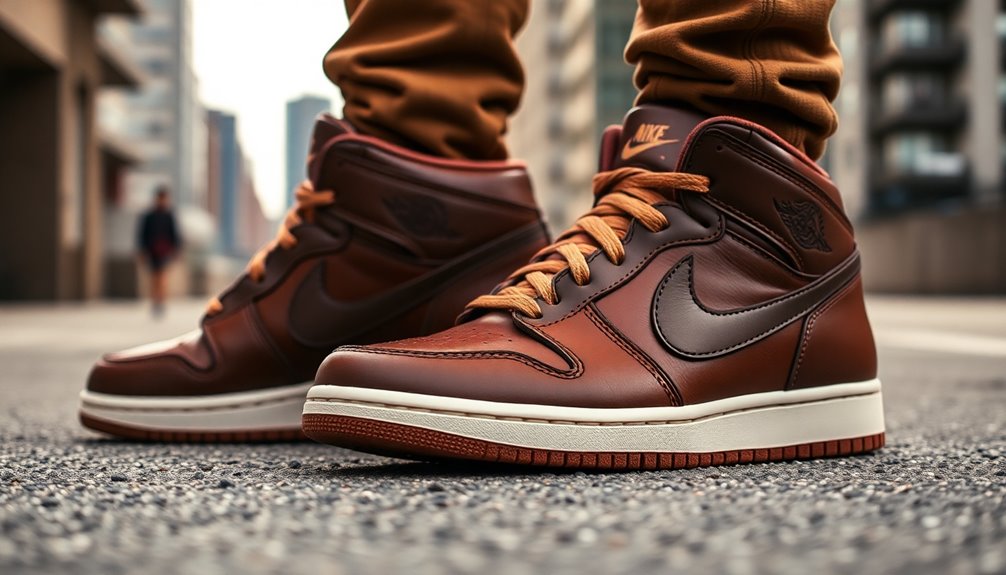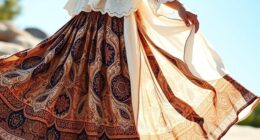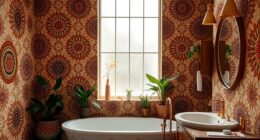In 2025, sustainable fashion becomes irresistibly stylish with eco-friendly materials like biodegradable fabrics, hemp, and organic cotton taking the spotlight. Upcycling waste into chic designs, transparent supply chains, and nature-inspired prints create an authentic, responsible look. Minimalist styles and tech-integrated apparel boost durability and innovation. By embracing circular fashion practices, you’re not just staying trendy—you’re making a positive impact. Keep exploring to discover how these trends can transform your wardrobe and style.
Key Takeaways
- Eco-friendly fabrics like biodegradable textiles, hemp, and organic cotton are shaping stylish, sustainable fashion for 2025.
- Upcycled and vintage-inspired designs promote uniqueness and reduce waste, making sustainable fashion both trendy and responsible.
- Nature-inspired motifs and earth-tone palettes create calming, authentic aesthetics aligned with eco-conscious values.
- Transparent supply chains and fair labor practices enhance consumer trust in eco-friendly fashion brands.
- Minimalist, tech-integrated, and circular fashion approaches ensure durable, versatile, and stylish eco-conscious wardrobe options.
Biodegradable and Renewable Fabrics Take Center Stage

As consumers become more eco-conscious, biodegradable and renewable fabrics are gaining popularity in fashion. These eco-friendly materials, like biodegradable fabrics, break down naturally, reducing landfill waste and environmental impact. Renewable textiles, sourced from sustainable resources such as hemp, bamboo, or organic cotton, offer alternatives to traditional fabrics that deplete finite resources. By choosing garments made from these materials, you support a circular economy and help lower carbon emissions. Fashion brands are increasingly adopting these fabrics to meet demand for sustainable options. Not only do biodegradable and renewable textiles enhance your wardrobe’s eco-friendliness, but they also often boast durability and comfort. Incorporating sustainable textile innovations made from these materials further encourages widespread adoption. Additionally, advancements in biodegradable fabric technology are making these textiles more accessible and functional for everyday wear. As your awareness grows, you play a crucial role in encouraging the industry to prioritize environmentally responsible production methods.
Upcycling: Transforming Waste Into Chic Fashion Statements
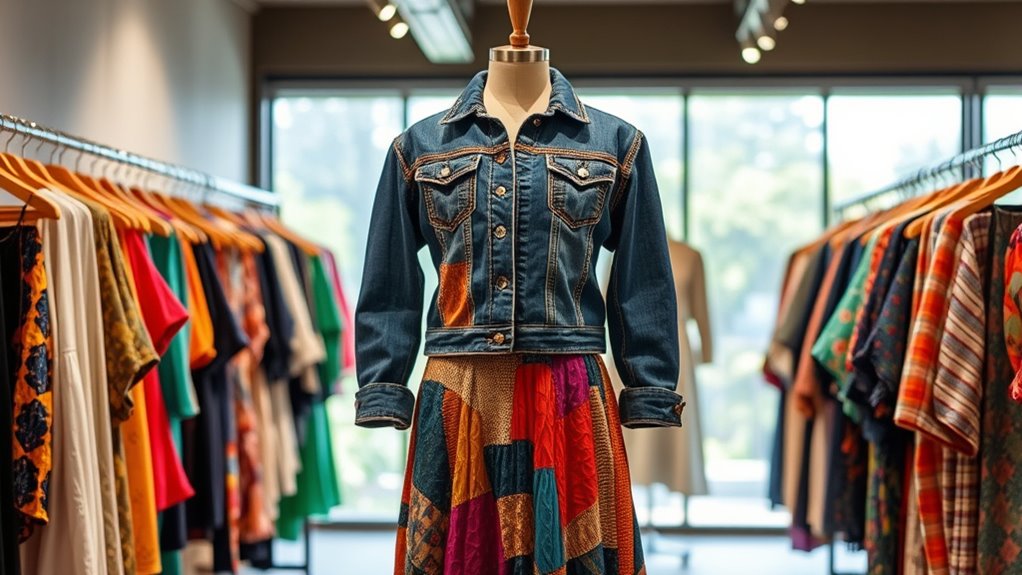
Upcycling turns waste into stylish fashion pieces through creative material reuse, giving old fabrics a new life. Vintage fabrics are making a comeback, adding unique character to modern designs. By focusing on eco-conscious innovation, you can help reduce waste while making bold fashion statements. Incorporating sustainable packaging practices into your designs can also add a touch of personality and style to your eco-friendly collections. Additionally, embracing ethical hacking principles can inspire innovative approaches to secure supply chains and protect sustainable fashion brands from cyber threats.
Creative Material Reuse
Creative material reuse, or upcycling, has become a powerful way to turn waste into fashionable statements. You can transform discarded items into stylish apparel by repurposing materials like recycled plastic bottles, which are turned into trendy fabrics. Using eco-friendly dyes ensures your creations stay vibrant without harming the environment. Imagine clothing with textures and colors derived from waste, giving new life to what would otherwise be trash. Here’s a visual to spark ideas:
| Material Source | Recycled Product | Eco-friendly Feature |
|---|---|---|
| Plastic bottles | Recycled polyester | Non-toxic dyes |
| Old denim | Patchwork jeans | Natural colorants |
| Discarded fabrics | Upcycled accessories | Biodegradable inks |
| Waste yarns | Knitwear | Water-based dyes |
Vintage Fabric Revival
Have you ever considered how vintage fabrics can be transformed into stylish, eco-friendly fashion? Vintage fabric and retro textiles hold unique character and history, making each piece one-of-a-kind. Upcycling these materials turns waste into statement apparel, reducing environmental impact and celebrating sustainability. By repurposing retro textiles, you create fashion that’s not only trendy but also conscious of resource use. You can find upcycled garments that showcase rich textures and patterns from past decades, giving new life to forgotten fabrics. This movement fosters creativity and minimizes waste, proving that sustainable fashion can be chic and innovative. Decluttering can help uncover forgotten textiles and inspire new creative uses for vintage fabrics. Exploring the history of pinball machines reveals how past innovations can inspire modern sustainable design practices. Additionally, understanding types of headphone jacks and their compatibility can help in repurposing old tech accessories for new fashion or functional uses. Vintage fabric revival is making eco-friendly choices both stylish and accessible for everyone.
Eco-Conscious Design Innovation
When waste materials are transformed into fashionable statements, designers demonstrate how eco-conscious innovation can reshape the industry. Upcycling plays a key role, turning discarded fabrics and materials into chic, one-of-a-kind pieces. High critical acclaim and box office success highlight the growing popularity of sustainable fashion choices. Zero waste manufacturing techniques minimize fabric waste during production, ensuring less landfill contribution and a smaller carbon footprint. Additionally, designers now source fibers from regenerative agriculture techniques, which restore soil health and promote biodiversity. This approach not only reduces environmental harm but also creates high-quality, sustainable textiles. By combining upcycling with zero waste practices and regenerative sourcing, you can embrace fashion that’s both stylish and eco-friendly. Dirt Cups and other creative desserts show the importance of repurposing and rethinking traditional methods. These innovations prove that sustainability doesn’t have to compromise creativity, making eco-conscious design innovation the future of fashion. Moreover, adopting sustainable payment processing methods can further support eco-friendly initiatives by reducing the carbon footprint associated with financial transactions.
Ethical and Transparent Supply Chains Gain Traction

As consumers become more conscious of their environmental impact, ethical and transparent supply chains are gaining significant traction. You’re demanding more visibility into how your clothing is made, pushing brands to prioritize supply chain transparency. This means companies are openly sharing details about their sourcing, ensuring materials come from responsible, ethical sourcing practices. When you choose brands that emphasize transparency, you support fair labor conditions and environmentally friendly production methods. Incorporating effective preparation into your purchasing decisions can further support these ethical initiatives. Additionally, increased consumer awareness is encouraging brands to adopt sustainable practices and improve their transparency efforts. Implementing traceability systems allows consumers to verify the origins of their products, fostering trust and accountability. Your choices are driving the movement toward a more sustainable and ethical future, where responsible supply chains are the norm rather than the exception.
Nature-Inspired Prints and Colors Embrace the Outdoors
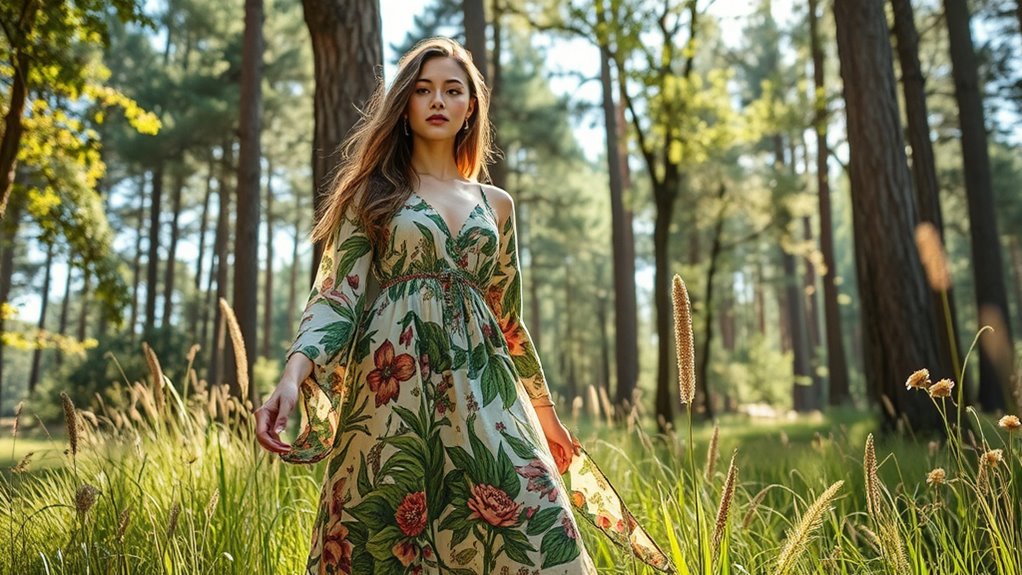
You’ll notice earth-tone palettes dominating new collections, bringing a natural vibe to everyday wear. Botanical prints are blooming everywhere, reflecting a love for the outdoors. Plus, nature-inspired accessories add the perfect finishing touch to eco-friendly outfits. Incorporating sustainable fashion options ensures your wardrobe aligns with environmentally conscious values. Additionally, designers are leveraging nature-inspired patterns in their designs to foster a deeper connection with the environment.
Earth-Tone Palettes Dominate
Earth-tone palettes are taking center stage in eco-friendly fashion, reflecting a growing desire to connect with nature. These shades, derived from natural pigments, create a calming, authentic aesthetic that resonates with sustainable values. Embracing earth tones means choosing colors inspired by soil, stone, and foliage, fostering a sense of harmony with the environment. By prioritizing natural pigments, you support eco-conscious production and reduce chemical use. This trend encourages you to embrace simplicity and authenticity in your wardrobe. It’s about more than style; it’s a statement of respect for the planet. When you wear earth tones, you’re making a conscious choice to honor the natural world and promote sustainability. Using natural materials in clothing production further enhances eco-friendly practices and reduces environmental impact, aligning with principles of minimalism for personal growth. Additionally, selecting clothing made from sustainable fabrics helps minimize reliance on synthetic dyes and reduces pollution.
Botanical Prints Flourish
Botanical prints are gaining popularity in eco-friendly fashion, bringing vibrant, nature-inspired designs into your wardrobe. These botanical prints feature lush leaves, delicate flowers, and organic motifs that evoke the outdoors. Floral patterns are evolving beyond traditional designs, embracing bold, artistic interpretations that celebrate nature’s diversity. Wearing these prints allows you to connect with the environment while making a style statement. Eco-conscious brands are incorporating sustainable fabrics like organic cotton and hemp to enhance these patterns’ appeal. Whether on dresses, shirts, or accessories, botanical prints make your look fresh and lively. They’re a perfect way to express your love for nature and support sustainable fashion trends. As these prints flourish, they remind you that embracing the outdoors can be both stylish and eco-friendly. sustainable fabrics can also inspire your fashion choices with eco-friendly and stylish designs. Additionally, choosing eco-friendly production methods helps reduce environmental impact and supports ethical practices in fashion.
Nature-Inspired Accessories
Have you noticed how nature-inspired accessories are elevating eco-friendly fashion? They bring the outdoors directly to your wardrobe, making sustainability stylish. Wildflower motifs bloom across jewelry and fabrics, symbolizing resilience and natural beauty. Leaf-shaped jewelry captures the essence of growth and renewal, reminding you of nature’s cycles. These accessories often use recycled or biodegradable materials, reducing environmental impact. Wearing them connects you to the environment, encouraging mindfulness and conservation. Incorporating healthy boundaries when choosing eco-friendly pieces can help ensure your fashion choices support your well-being and values.
Minimalist Designs With a Sustainable Twist
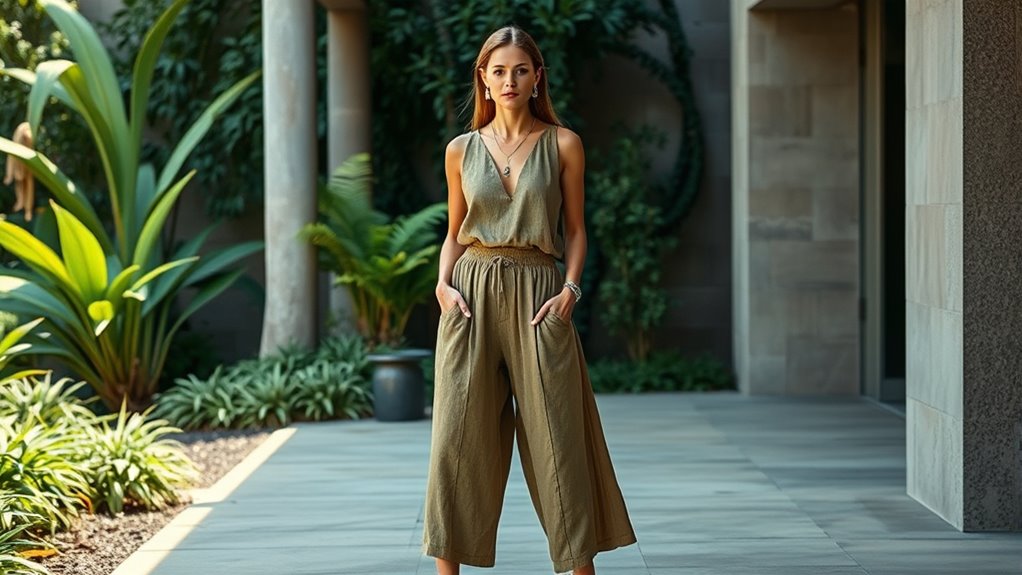
While minimalist designs have long emphasized simplicity and versatility, integrating sustainable principles takes them to a new level of intentionality. You’ll notice that eco-friendly minimalism blends clean lines with environmentally conscious choices, making your wardrobe both stylish and responsible. These designs focus on quality over quantity, reducing waste and promoting durability. By choosing sustainable fabrics and ethical production, you embody eco friendly simplicity without sacrificing elegance. Here’s how the trend unfolds:
| Sustainable Minimalism | Eco-Friendly Simplicity |
|---|---|
| Focuses on timeless pieces | Prioritizes eco-conscious materials |
| Uses biodegradable fabrics | Emphasizes minimal accessories |
| Promotes durability | Reduces fast fashion reliance |
| Combines function & style | Supports ethical brands |
| Enhances versatility | Encourages mindful consumption |
Tech-Integrated Eco-Friendly Apparel for Modern Living

As technology advances, eco-friendly apparel is becoming smarter and more integrated into your daily life. Wearable tech and smart textiles now offer sustainable solutions that enhance comfort and functionality. You can track your health, adjust temperature, or even generate energy through your clothing—all while reducing environmental impact. These innovations promote mindful consumption and long-term durability, making your wardrobe both stylish and eco-conscious.
Smart, eco-friendly clothing seamlessly integrates technology to enhance comfort, health, and sustainability in everyday fashion.
- Enhanced durability reduces waste over time
- Self-cleaning fabrics lower water usage
- Energy-harvesting textiles power devices naturally
- Embedded sensors optimize physical well-being
- Modular designs support adaptable, long-lasting outfits
Circular Fashion: The Future of Wardrobe Sustainability

Circular fashion is transforming the way you think about wardrobe sustainability by emphasizing reuse, recycling, and longevity. It encourages you to contemplate the entire clothing lifecycle, reducing waste and extending the life of your garments. As consumer behavior shifts towards sustainability, more brands offer rental, repair, and upcycling options. This approach minimizes environmental impact and promotes a mindset of mindful consumption.
| Benefits of Circular Fashion | How You Can Participate |
|---|---|
| Reduces waste | Rent or swap clothes |
| Extends clothing lifespan | Repair and upcycle garments |
| Lowers environmental impact | Buy from sustainable brands |
| Promotes responsible behavior | Support clothing recycling programs |
Frequently Asked Questions
How Do Eco-Friendly Fabrics Compare in Durability to Traditional Materials?
When comparing eco-friendly fabrics to traditional materials, you’ll notice biodegradable fibers often match or surpass synthetic durability, making them practical choices. While some biodegradable options may need gentle care, they’re designed to last, and innovations improve their resilience. Synthetic durability remains strong, but eco-friendly fabrics now offer comparable performance, letting you enjoy stylish, sustainable fashion without sacrificing longevity. You can confidently choose eco-fabrics that are both durable and environmentally conscious.
What Are the Biggest Challenges in Scaling up Upcycled Fashion?
You face challenges in scaling up upcycled fashion, mainly due to limited design innovation and market acceptance. As you push for broader adoption, you need to develop creative designs that appeal to consumers. Overcoming skepticism and educating buyers about sustainability are essential. By focusing on innovative ideas and increasing market acceptance, you can help upcycled fashion grow, making eco-friendly choices more mainstream and accessible.
How Transparent Are Brands About Their Supply Chain Practices?
Imagine browsing your favorite brand’s site, expecting honesty, yet uncovering hidden details. Many brands are more transparent about their supply chain practices than ever before, but gaps remain. They’re increasingly embracing supply chain transparency and ethical sourcing, yet some still withhold full details. You can often find labels or reports, but full transparency isn’t universal. You have the right to demand clear info on how your fashion is made and sourced ethically.
Can Nature-Inspired Prints Be Sustainably Produced at Large Scale?
You can produce nature-inspired prints sustainably on a large scale by using biodegradable dyes and eco-conscious manufacturing processes. These methods reduce environmental impact while maintaining vibrant designs. When brands prioritize biodegradable dyes, they ensure that prints break down naturally, minimizing waste. Eco-conscious manufacturing also involves responsible resource use and waste management. By adopting these practices, you help support a more sustainable fashion industry that celebrates nature’s beauty without harming the planet.
What Innovative Tech Is Being Integrated Into Sustainable Apparel for Comfort?
You’ll find that innovative tech like smart textiles and wearable sensors are transforming sustainable apparel for comfort. These advancements allow fabrics to regulate temperature, wick moisture, and adapt to your body’s needs, all while reducing environmental impact. By integrating smart textiles, brands make your clothing more functional and eco-friendly, so you stay comfortable and stylish without compromising sustainability. This tech truly elevates the future of eco-conscious fashion.
Conclusion
You wear sustainability like a badge of honor, embracing fabrics that break down gently, upcycling waste into style, and choosing transparency over doubt. You step into nature-inspired hues, adopt minimalist designs with a conscious heart, and incorporate tech that connects you seamlessly to eco-living. You champion circular fashion, creating endless possibilities, endless beauty, and endless purpose. Together, you shape a future where fashion isn’t just worn, but lived—sustainable, stylish, and undeniably sexy.
